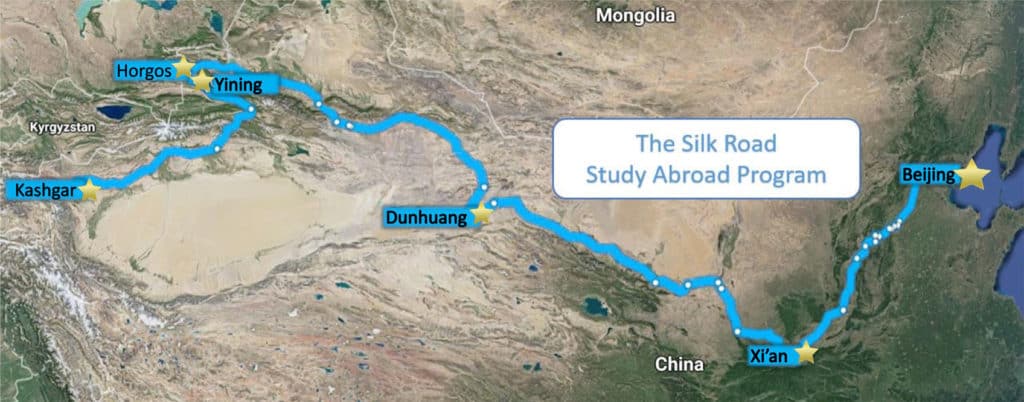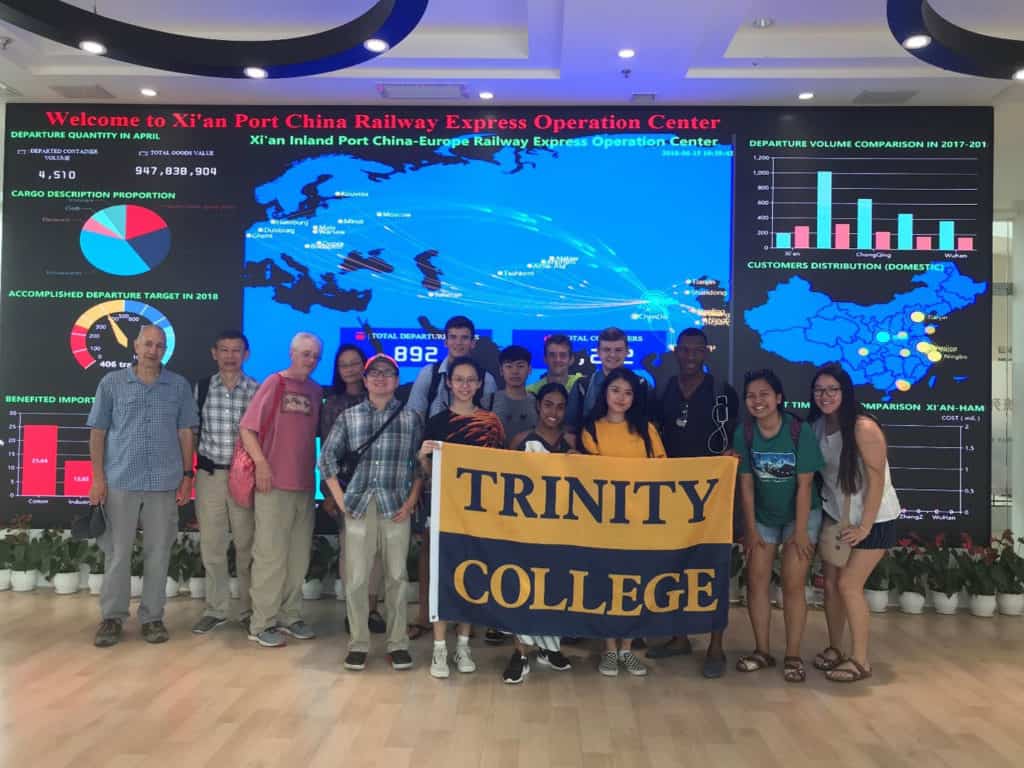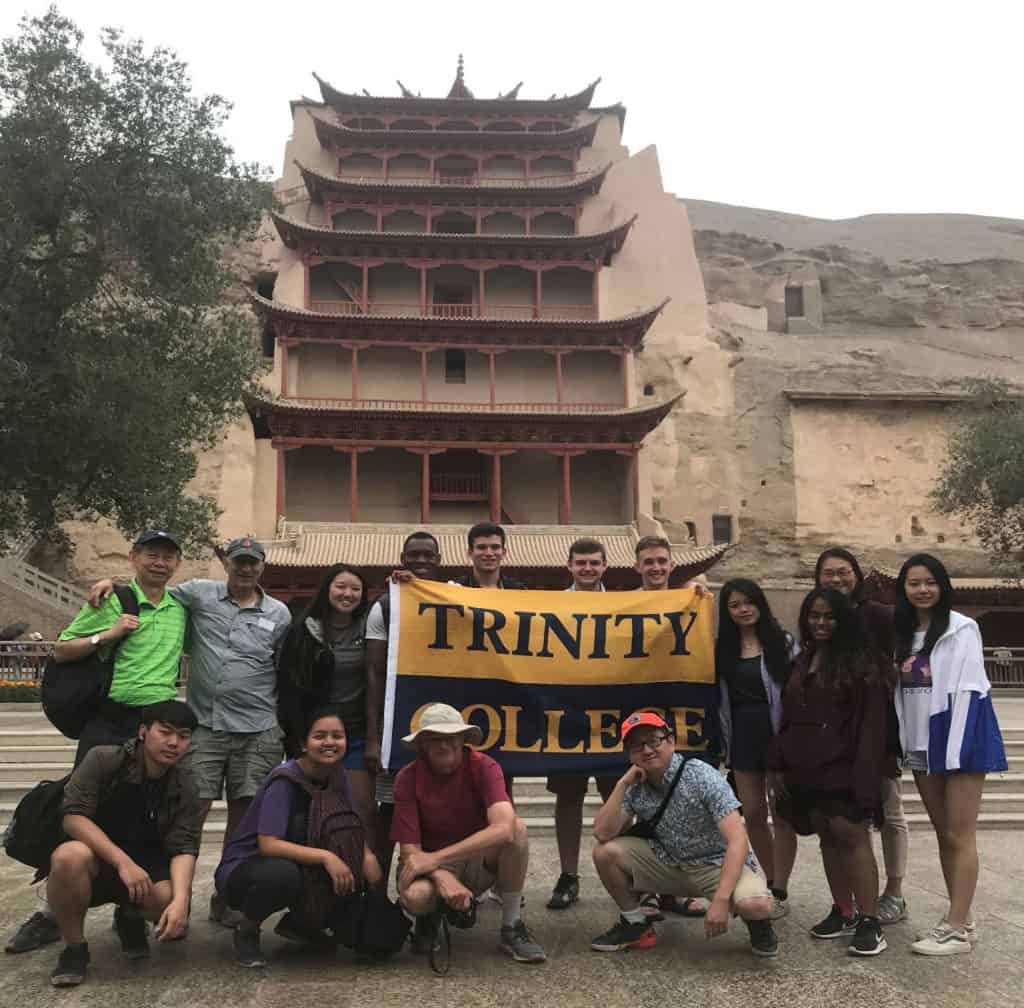Hartford, Connecticut, August 22, 2018—Trade and cultural ties along the ancient Silk Road linked historic cities in China to great urban centers in Central Asia and Europe for around two millennia. In summer 2018, Trinity College’s China summer program took 11 students and five faculty members on a study journey through five cities in northern China (see map) as part of the program, “Silk Road Cities: A Field Investigation of Routes of Trade and Cultural Connections from Ancient Times to the Present.”
Organized by the Center for Urban and Global Studies (CUGS) with multiple sponsorships, the Silk Road program marked Trinity’s 10-year anniversary of traveling field investigations in China and Southeast Asia. The program was taught jointly by Associate Professor of History Michael Lestz, Hobart Professor of Classical Languages Gary Reger, and Associate Professor of Language and Culture Studies and International Studies Yipeng Shen, with contributions from Paul E. Raether Distinguished Professor of Global Urban Studies and Sociology Xiangming Chen, dean and director of CUGS, and Yunchiahn Sena, Kluger Visiting Assistant Professor of Fine Arts.
 The program started in Beijing with visits to the Great Wall and the Forbidden City. A lecture by Professor Zhang at Beijing Normal University, coupled with a tour of the Beijing Planning Museum, gave the Trinity group a combined historical and contemporary perspective on Beijing as a historically and culturally rich global megacity.
The program started in Beijing with visits to the Great Wall and the Forbidden City. A lecture by Professor Zhang at Beijing Normal University, coupled with a tour of the Beijing Planning Museum, gave the Trinity group a combined historical and contemporary perspective on Beijing as a historically and culturally rich global megacity.
In the ancient city of Xi’an, we saw the Terracotta Soldiers, the tomb army of Qin Shi Huang, the first emperor of China, 210–209 BCE, and visited the Banpo Neolithic Village site. This was followed by a guided tour of the Xi’an International Land Port, which is the new terminus of a busy China-Europe freight rail line. These visits revealed Xi’an as both the eastern beginning point of the old Silk Road and a renewed place of departure for China’s Belt and Road Initiative, which was designed to connect to Europe through Central Asia.
From Xi’an, we went further west to Dunhuang in Gansu province, an oasis town of the Silk Road. It is famous for the “Grottos of the Thousand Buddhas,” which are manmade chapels created from the 6th century to the end of the Qing Dynasty in the late 19th century. In Dunhuang, we visited the Buddhist caves and the remnants of the Han dynasty Great Wall. A camel ride gave us a real glimpse on the vast Gobi Desert that the old caravans had to pass along the Silk Road.

After Dunhuang, we traveled further west to three cities in Xinjiang. The first stop was Yining, the most populous city in the Ili Kazakh Autonomous Prefecture. Then we visited the city of Horgos, bordering Kazakhstan. An old land port on China’s western frontier along the Silk Road, Horgos was portrayed in a video at the local planning museum as a new trade and logistics hub for China’s Belt and Road Initiative. Finally, we reached the city of Kashgar, China’s westernmost city, near the border with Pakistan. Kashgar’s history goes back around 2,000 years, with an Old Town that has stood for more than 800 years. The visit to the Id Kah Mosque, the largest in China, showed Kashgar as a major meeting and melting point of Chinese and Muslim cultures on the Silk Road. Today, Kashgar marks the end of the China-Pakistan Economic Corridor (CPEC), a lynchpin of China’s Belt and Road Initiative.
Reflecting back on his participation, Trinity student Tom Peduto ’21—a Cities Program student planning to major in political science—said, “Through Trinity’s Silk Road Cities program, I learned first-hand about the successes and challenges in the long history of China and what its ambitious Belt and Road Initiative may bring in the future. The opportunity to travel and study along the Silk Road allowed my studies in Hartford to reach a global perspective.”
Philisha Abrahim ’20, planning to double-major in urban studies and psychology, added, “Trinity’s Silk Road experience has given me unforgettable memories. It pulled me to heights of great cultural understanding. It pushed me far out of the depths of my comfort and into new adventures. I was awed by the complex history of China’s great cities and will be able to effectively use that knowledge in my future in urban studies.”

By integrating historical and cultural perspectives in multiple local settings, this program has provided students with a broad but grounded understanding of the diverse intersections between the past, present, and future of several distinctive Silk Road cities in China. Through a multi-disciplinary approach to teaching in this program, the faculty participants have gained new pedagogical experience and expertise that can improve teaching in the classroom and the field.
The Silk Road Cities program, like its predecessors focused on river cities in China and Southeast Asia, was generously supported by the Henry Luce Foundation, the Thomas China Urban Research and Teaching Endowment, the O’Neill Asia Cum Laude Endowment, and the Charlotte Riggs Scholarship Fund.
Written by Xiangming Chen, Paul E. Raether Distinguished Professor of Global Urban Studies and Sociology and Dean and Director of the Center for Urban and Global Studies; Michael Lestz, Associate Professor of History; and Yipeng Shen, Associate Professor of Language and Culture Studies and International Studies. Header photo: At the Terracotta Soldiers Museum, Xi’an, China
